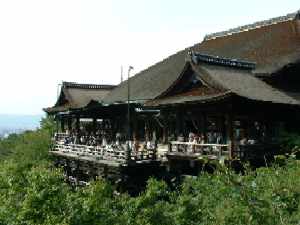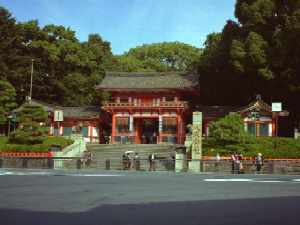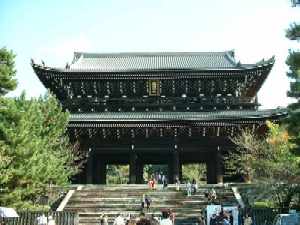Higashiyama (middle)
Higashiyama, or East Mountain provides us with many good temples to see. Kiyomizu-dera and Ginkaku-ji are most famous among them though other temples are good as well. You can probably see most of these in a single day, say, 9:00 to 17:00, but I would rather use two days. Here, I will show you the southern half of the area.
It was early October. When I got out from an underground railway station, there was thick sweet scent of fragrant olive blossoms. It was like that someone dumped perfume all over the city. When I got closer to one of the trees, the scent was so thick that I felt like liquid of scent flew into my nose.
Kiyomizu-dera temple

I took a bus to Kiyomizu-michi from the busiest quarter in Kyoto, Shijo-Kawaramachi. It took about 10 minutes and a fare of 220 yen. I climbed an upgrade path to Kiyomizu-dera. There was a parking lot at about halfway to the temple and a big crowd was there. There were groups of high school students, groups of senior people. Also there were many people from foreign countries. It was the first day of three-day weekend.
There were souvenir shops on the both sides of the road. As I walked along, I smelled scent of incense from a small temple or shops and of cookies and pickles from those souvenir shops as well as the scent of the fragrant olive blossoms. If those scent had colors, the colors would change as you walked and would be beautiful to see. Or, you might be confused by mixed colors...
At the end of the busy road, I saw a stone stairway that was closed and a cinnabar red gate on top of the stairway. A three-storied pagoda was behind the gate. Then I saw a belfry that looked newly painted. Obviously they were refurbishing the buildings. I wondered if they would paint the main hall. I assumed they would not. Though it might sound like an illogical reason, I just could not imagine the vermilion-lacquered main hall.
I climbed another stairway to the temple. I paid an admission fee of 300 yen at the box office and went in to the main hall. From the stage, or veranda of the main hall, you can see a small valley and the city of Kyoto as well as some buildings of Kiyomizu-dera complex. I walked around the complex and admired the supporting structure of the stage of the main hall. It was constructed with 139 pillars and no nails were used.
Then I went down a slope that is called San'nen-zaka toward north. There were souvenir shops, teahouses and restaurants along this rather narrow road. Then I made a detour to Yasaka-no-to, or Yasaka pagoda instead of going on toward Ninen-zaka.
Yasaka-no-to

I had not been interested in this pagoda very much and I had thought that I would take just a couple of pictures for this site and leave. As I walked beside the wall that surrounded the five-storied pagoda, I found that they allowed visitors to get in the pagoda.
I paid an admission fee of 400 yen. They gave me a leaflet by which I learned that Yasaka-no-to originally was built in the year 678 which was well before Kyoto was founded as the capital of Japan. The pagoda burned down three times and the current structure was built in 1436.
I went in it. There sat five statues on the first floor. The statues were not clean. I assumed that they intentionally did not clean the statues. If they routinely had been cleaning the statues for hundreds of years, thin gold leaves would have gone. To clean or not would be a tough decision, wouldn't be?
I climbed a narrow staircase to the second floor. Though there were nothing special, I admired the structure of the pagoda. A single thick pillar supported the pagoda.
Although it was the second day of three-day weekend, there were not many people. While I was in the pagoda, only a couple came in.
I do not know if there are other pagodas that are open to public.
When I was walking toward Ninen-zaka, I saw a Maiko (a traditional dancing girl in Gion, Kyoto) in brilliant kimono dress. I thought that she was not a real Maiko but a visitor in Maiko costume. This place was not Gion and Maiko could not be walking here especially in the daylight. Nevertheless, I took a couple of pictures of her. I had a chance to take a good picture. I thought the chance was so good and I was in a harry to handle the camera. The result was a blurred picture. D--n it.
Kodai-ji temple

walked on Nene-no-michi road that was named after a woman called Nene. Then I stopped by Kodai-ji temple that Nene founded after her husband, a sovereign ruler had passed away.
You might notice a big white statue next to Kodai-ji. It was concrete built Ryozen-kan'non, or Ryozen Bodhisattva of Compassion. As I was not interested in concrete statue, I took only a brief look at it.
I paid an admission fee of 600 yen and walked in to the garden of Kodai-ji. Five main buildings were connected by covered corridors. One of the corridors was called Garyu-ro that meant lying dragon corridor since it looked like a lying dragon. Though it was an interesting structure, it was close to public.
There were two thatched huts on top of a hill in the temple. Both were teahouses for tea ceremony and had been designed by Sen no Rikyu, the founder of Tea Ceremony. Both looked like just poor huts but they were said of great design which I honestly did not understand much. One was called Kasa-tei or "Umbrella Arbor and the other Shigure-tei or Shower-in-late-fall Arbor.
Then I went down on a narrow path in bamboo grove. I took off shoes at the entrance of Hojo. A couple of ladies were providing plastic bags for shoes to visitors. I went through the building. There were beautiful Fusuma-e paintings and a rock garden.
Yasaka-jinja shrine

Next, I went to Yasaka-jinja through Maruyama-koen (Maruyama park). Yasaka-jinja is the shrine of Gion-matsuri. They were repairing the main building and I just left the shrine.
Chion-in temple

It was a three-day weekend of early November. When I got out of Maruyama-koen, I saw a big gate. It was the entrance gate of Chion-in temple. They say that it is the largest among existing wooden gate in the world.
When I got closer to the gate, I saw people on the verandah. They said that the second floor of the two-storied gate would be open to public twice a year. I was lucky to visit here when they allowed people to see the beautiful room in the gate.
I paid an admission fee of 800 yen at the entrance of the staircase of the gate. I took off my shoes and put them in a plastic bag they provided to me. I climbed the steep stairs carefully so that I would not tumble down to the root of the staircase. On the second floor of the gate, there were statues of Buddha and his 16 disciples in the sole room. A guide of the temple gave explanation to visitors about the gate and statues.
The gate was built in 1615 by an order of the second shogun of Edo era, Tokugawa Hidetada (please note that the first name is the family name) and the paintings on the walls, pillars and the ceilings were still not faded.
The view from the second floor verandah was rather disappointing. You would see concrete buildings of modern Kyoto.
I went back to the ground and went through the gate. There were two stone stairs, one is steeper and called Otoko-zaka, or male slope and the other is a gentle slope and called On'na-zaka, or female slope. I climbed the Otoko-zaka. On top of the stairs, I saw several buildings. The largest was the main building that four thousand people could get in at the same time, they said. I did not know if it was true. May be it was if people stood shoulder to shoulder, back to stomach.
I think I should tell one more thing on this temple. It is a bell. The bronze bell was cast in 1636 and is the biggest in Japan, which weighs more than 70 tons. Wow!